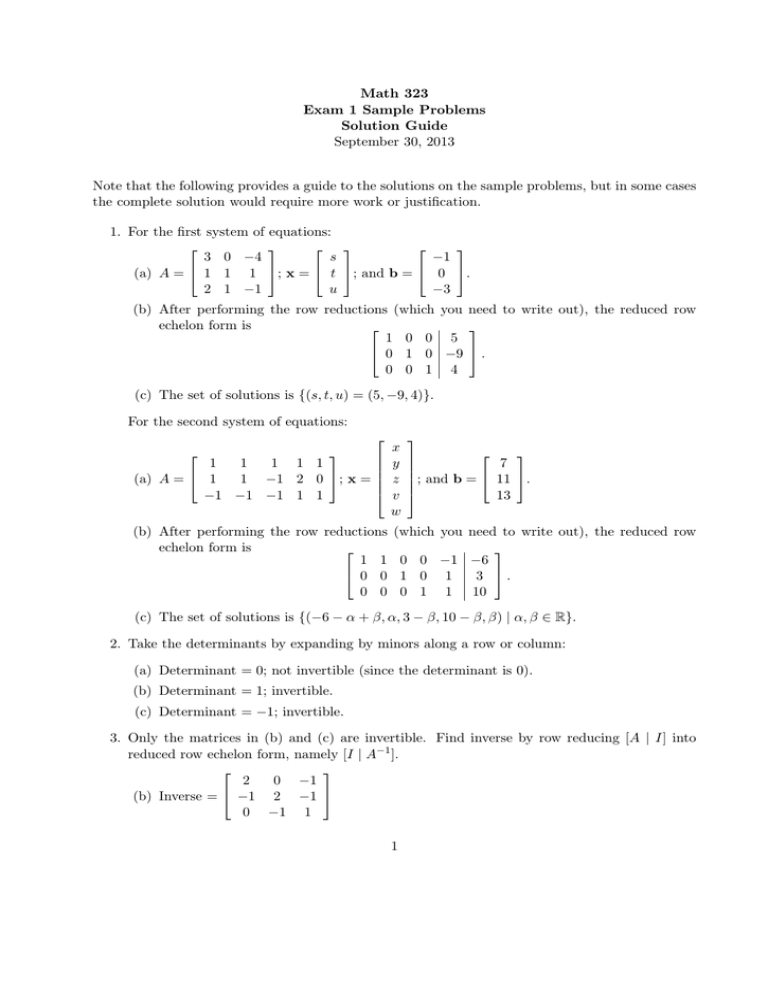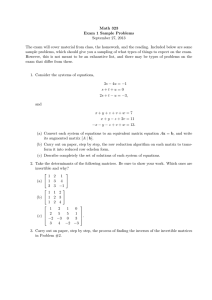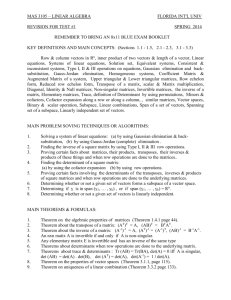Math 323 Exam 1 Sample Problems Solution Guide September 30, 2013
advertisement

Math 323
Exam 1 Sample Problems
Solution Guide
September 30, 2013
Note that the following provides a guide to the solutions on the sample problems, but in some cases
the complete solution would require more work or justification.
1. For the first system of equations:
3 0 −4
s
−1
(a) A = 1 1 1 ; x = t ; and b = 0 .
2 1 −1
u
−3
(b) After performing the row reductions (which you need to write out), the reduced row
echelon form is
1 0 0 5
0 1 0 −9 .
0 0 1 4
(c) The set of solutions is {(s, t, u) = (5, −9, 4)}.
For the second system of equations:
1
1
1 1 1
1
1 −1 2 0 ; x =
(a) A =
−1 −1 −1 1 1
x
y
z
v
w
(b) After performing the row reductions
echelon form is
1 1
0 0
0 0
(which you need to write out), the reduced row
0 0 −1 −6
3 .
1 0 1
0 1 1 10
7
; and b = 11 .
13
(c) The set of solutions is {(−6 − α + β, α, 3 − β, 10 − β, β) | α, β ∈ R}.
2. Take the determinants by expanding by minors along a row or column:
(a) Determinant = 0; not invertible (since the determinant is 0).
(b) Determinant = 1; invertible.
(c) Determinant = −1; invertible.
3. Only the matrices in (b) and (c) are invertible. Find inverse by row reducing [A | I] into
reduced row echelon form, namely [I | A−1 ].
2
0 −1
(b) Inverse = −1 2 −1
0 −1 1
1
−51 15 7
31 −9 −4
(c) Inverse =
−10 3
1
−3
1
1
1 −2 0
4. (a) Let E = 0 1 0 and
0 0 1
(b) Answers may
1 0
E3 = 0 1
0 3
12
−7
2
1
1 0 0
F = −1 1 0 .
0 0 1
1 0 0
vary. Can take E1 = 0 1 0 ; then E2
−1 0 1
0
1 0 −3
1
0 ; then E4 = 0 1 0 ; then E5 = 0
1
0 0 1
0
1 0
0 − 12
=
0 0
0 0
1 −1 .
0 1
0
0 ; then
1
5. Here we first calculate
−1
AB =
−1
2 2 0
4
Therefore, (AB)2 =
=
0 2
0
0
2
−2 0
−1 1
=
2 0
0 2
.
0
8 0
3
, and similarly (AB) =
. In general,
4
0 8
n
2
0
n
.
(AB) =
0 2n
a c
a b
T
. Thus,
, and so A =
6. Suppose A =
b d
c d
det(A) = det(AT ) = ad − bc.
Now since AAT = I, we have that AT = A−1 . Since
1
det(A−1 ) =
,
det(A)
we see that
det(A) = det(AT ) = det(A−1 ) =
that is det(A) =
1
det(A) ,
1
;
det(A)
which gives det(A)2 = 1. Thus, det(A) = ±1.
7. The lower left entry of A should be − cos(x) sin(y); it has now been corrected in the problem
set. Expand the first row by minors:
cos(x) − sin(x) cos(y) sin(x) sin(y) cos(x) − 0 + sin(y) det(A) = cos(y) − cos(x) sin(y) sin(x) sin(x) cos(x) cos(y) = cos(y)(cos2 (x) cos(y) + sin2 (x) cos(y)) + sin(y)(sin2 (x) sin(y) + cos2 (x) sin(y))
= cos2 (y)(cos2 (x) + sin2 (x)) + sin2 (y)(sin2 (x) + cos2 (x))
= cos2 (y) · 1 + sin2 (y) · 1
= 1.
So det(A) = 1, regardless of x and y.
2
8. Determine if the following sets of vectors are or are not vector spaces. If they are not, explain
why.
(a) V = solution set of the equations x + y − z − w = 0 and x + y + 2w = 0 in R4 .
Solution: This is a vector space. Solution sets of homogeneous systems of linear equations
are always vector spaces. (They are the nullspaces of the their corresponding coefficient
matrices.)
(b) W = [ xy ] y = x + 1 .
x
Solution: W is not a vector space. Notice that ( 12 ) ∈ W but that 2 · ( 12 ) = ( 24 ) ∈
/ W . So
W is not closed under scalar multiplication.
(c) X = set of upper triangular 3 × 3 matrices.
Solution: X is a vector space. We know that the set of 3 × 3 matrices forms a vector
space. One needs only check that X is closed under addition and scalar multiplication.
(On the exam, you would indeed want to check this for full credit!)
9. (a) Check directly that Ax = 0.
(b) The equations are 2x1 − x2 = 0 and 2x2 + x3 = 0.
(c) We transform A into reduce row echelon form to find that
1 0 41 0
A ←→ 0 1 12 0 .
0 0 0 0
In this case, x1 and x2 are leading variables, and x3 and x4 are free variables. S
α
−
α4
−
2
N (A) = α, β ∈ R .
α
β
10. By symmetry, we need only show that if A is row equivalent to B then B is row equivalent
to A. Suppose that A is row equivalent to B. Then there are elementary matrices E1 ,
E2 , . . . , Ek , so that
(Ek · · · E1 )A = B.
This implies that
(Ek · · · E1 )−1 B = A.
Now
(Ek · · · E1 )−1 = E1−1 · · · Ek−1 ,
and the inverse of an elementary matrix is itself an elementary matrix. Therefore,
E1−1 · · · Ek−1 B = A,
and so B is row equivalent to A.
3
11. By interchanging row 1of M with row k + 1, row 2 with row k + 2, and so on, we see that
M is row equivalent to A0 B0 . Since we have made k row swaps, we see that
A 0
det(M ) = (−1) det
.
0 B
k
(The following proof is good to know in principle, but in its entirety would be beyond the
scope of an exam.) We now proceed by induction on k. If k = 1, then A and B are simply
scalars (1 × 1 matrices), and so det(M ) = (−1)k AB as desired.
A 0 Suppose that the result is
true for all k, 1 ≤ k ≤ ` − 1. Expand the determinant of 0 B along the top row: letting
Aij be the ij-minor of A, we see that
A 0
A11 0
A12 0
A1k 0
k+1
det
= a11 det
− a12 det
+ · · · + (−1) a1k det
.
0 B
0 B
0 B
0 B
Now expand each of the B’s along
A 0the
bottom row. After the dust settles and you simplify
the expressions, you obtain det 0 B = det(A) det(B).
12. Suppose that S is a subspace of R1 . Suppose that S 6= {0}. Therefore we can pick x0 ∈ S
with x0 6= 0. Since S is a subspace, it is closed under scalar multiplication, so for any c ∈ R,
we that cx0 ∈ S. Now suppose y ∈ R. We want to show that y ∈ S. Let c = xy0 . Then
cx0 =
y
· x0 = y ∈ S.
x0
Therefore R1 ⊆ S, so S = R1 .
4



